
William Labov is regarded as the founder of variationist sociolinguistics, a discipline dedicated to understanding and researching language in relation to social factors that include region, class, and gender. Dr. Labov has worked to promote literacy for speakers of nonstandard dialects and to develop reading and teaching materials for these populations.
At a virtual program that included remarks from Academy President David Oxtoby, University of Pennsylvania Provost Wendell Pritchett, and Stanford University linguist Penelope Eckert, the Academy presented the Talcott Parsons Prize to William Labov for his distinguished and original contributions to the social sciences. An edited version of Dr. Labov’s acceptance remarks follows.
2095th Stated Meeting | January 6, 2021 | Virtual Event
William Labov is Professor of Linguistics at the University of Pennsylvania. He was elected a Fellow of the American Academy of Arts and Sciences in 1976.
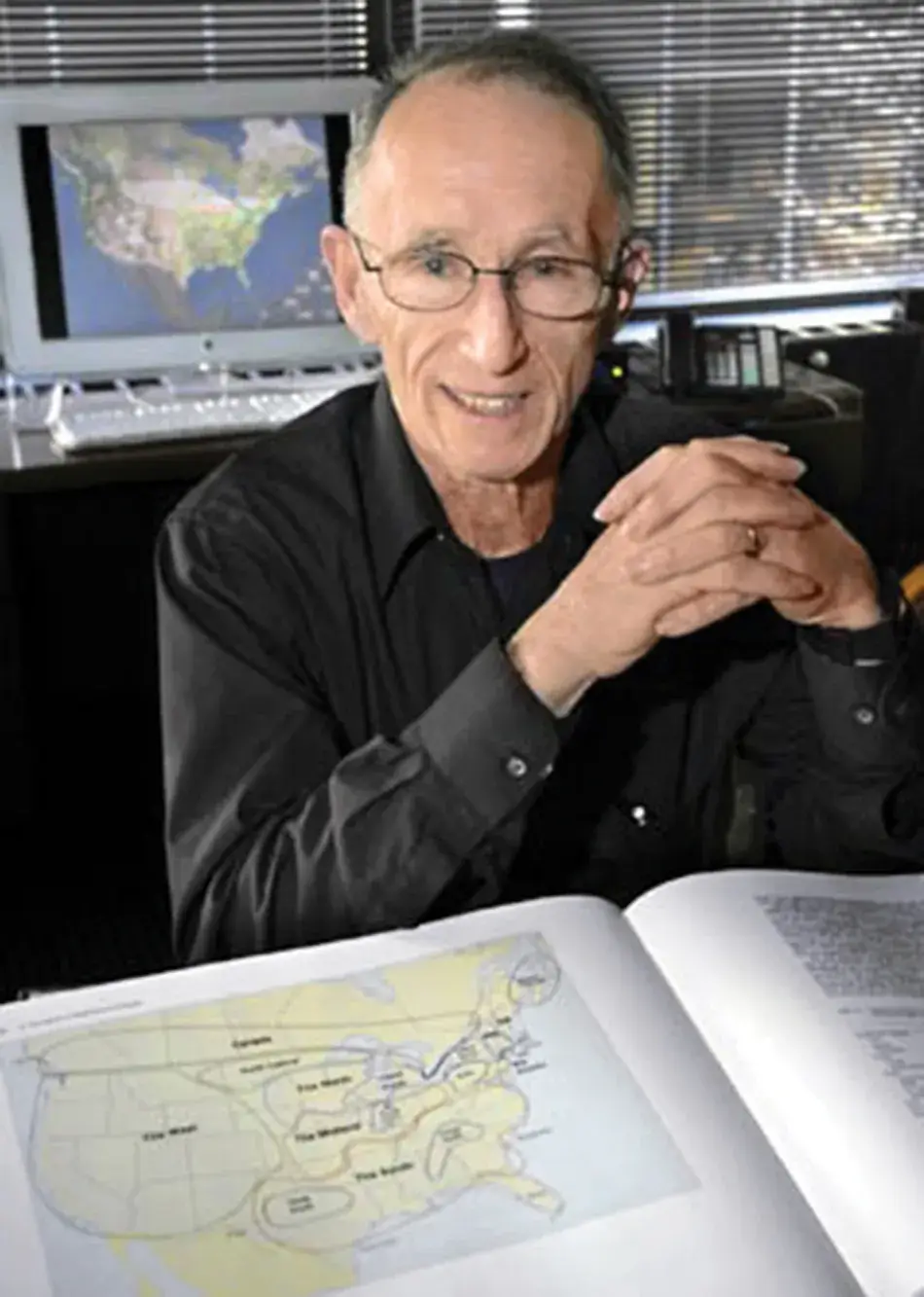
I very much appreciate this meeting, and I am honored to receive the Talcott Parsons Prize in recognition of the contributions that I have made to linguistics since I entered the field in the 1960s. I would like to acknowledge the help of my colleague Gillian Sankoff at every stage of the preparation of these remarks.
Entering the University
I entered the field of linguistics at the age of thirty-three. I had worked previously for ten years as an industrial chemist, and so I brought with me the habits of numerical recording, testing, and experimentation. I left behind my friends in the factory and a decade of trade secrets and entered into the open pursuit of the universal properties of human language at Columbia University. There I found that linguists had a very different mode of gathering data: they would ask, “Can you say this?” or else would rely on introspection.
It occurred to me that the field could profit by the adoption of a new invention, the tape recorder, that preserved what people actually did say. It was fortunate that I brought my numerical habits with me, because I found that the variation in the way people said the very same words could be measured, and that variation was subject to a number of social parameters.
Numbers in New York
In my first efforts to record linguistic variation, I introduced the concept of the linguistic variable: a closed set of possible options with a single underlying value. But linguistics was not yet ready for that idea. A senior colleague told me that the only numbers in linguistics were the numbers on the pages.
I expected decades of stiff resistance to the quantitative study of change and variation. But I was surprised. My first report on “The Social Motivation of a Sound Change” on Martha’s Vineyard was greeted with a wave of approval at the national meeting of the Linguistic Society of America. I later took a course on Survey Methodology at Columbia’s Bureau of Applied Social Research, and carried out a survey of New York’s Lower East Side using a piggy-back design, a subset of the survey of Delinquency and Opportunity by Richard Cloward and Lloyd Ohlin. The graph in Figure 1 is typical of the results. It builds from the observation that New Yorkers sometimes pronounce the (r) in words like hard core and sometimes do not.
Figure 1. New York City (r) in 1964
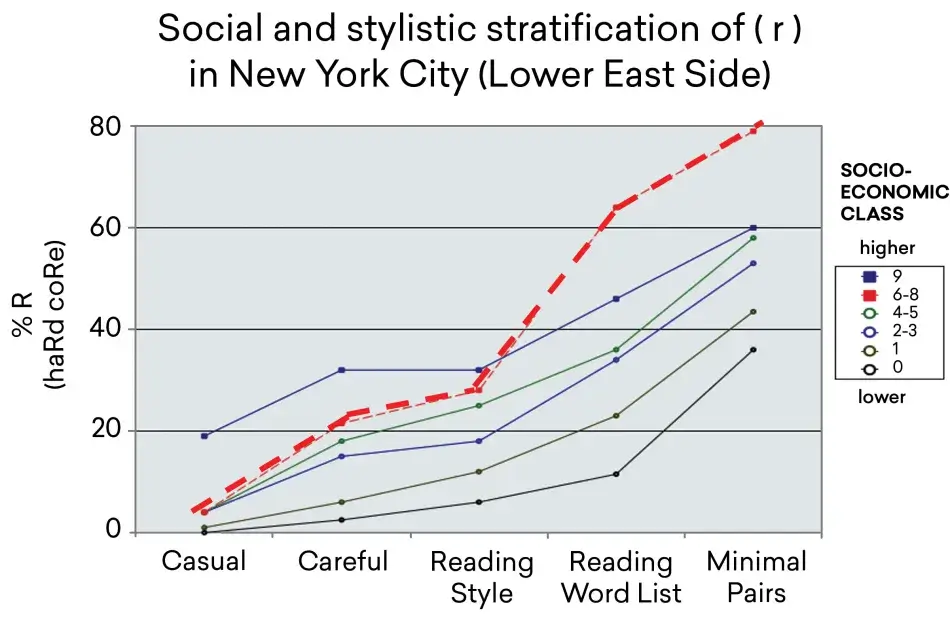
The graph is based on the speech of the eighty-one adults whom I interviewed on New York’s Lower East Side, grouped into six social classes. The percent pronunciation of consonantal (r), shown in the vertical axis, is very low in casual conversation: less than 20 percent by most speakers, as we see at the lower left. It increases to over 50 percent in the more formal styles on the right-hand side of the figure.
The data clearly show that (r) pronunciation was conditioned by speech style and by the speaker’s social status, but there was a third conditioning factor: the speaker’s age. The younger the speaker, the greater their use of consonantal (r), and this reflected an ongoing change in the speech of New Yorkers.
Sociolinguistics, based on the quantitative analysis of language variation and change, became a burgeoning field. In 1988, I was the founding co-editor of Language Variation and Change, which is now in its thirty-third year of publication. Since then, several other journals in variationist sociolinguistics – such as Asia-Pacific Language Variation, Journal of Sociolinguistics, and Journal of Historical Sociolinguistics – have appeared. Most of the papers in these journals are based on automatic assessment of data by mixed-level, maximum-likelihood regression analysis, data that now take an hour to analyze that previously would take a month. Let me add that the 49th annual NWAV conference (New Ways of Analyzing Variation) will be held in Austin, Texas, in October 2021.
Searching for Linguistic Justice
At several points in the citation of my Talcott Parsons Prize, there is mention of my concern for social justice. The quantitative analysis of the pronunciation of (r) did not automatically lead to a concern with such matters, but there were social issues involved with the speech of young Black people in New York. The Office of Education funded a study of mine of what was then recognized as “nonstandard Negro English” (now generally referred to as African American Vernacular English, or AAVE).
The goal of the research was to find out the connection, if any, between that speech pattern and the high rate of reading failure in Harlem schools. I enlisted two young Black men to interview members of local street clubs at a club house that I rented on 112th Street. One result of that work appeared in the Teachers College Record (see Figure 2).10 It showed an overwhelming difference in reading progress between the forty-six members of the local groups – the Cobras, the Jets, the T-Birds – and the thirty-two non-members of the street groups. We found correlated differences in their use of language: the street club members spoke AAVE in its most consistent form.
Figure 2. Reading scores of street club members and others
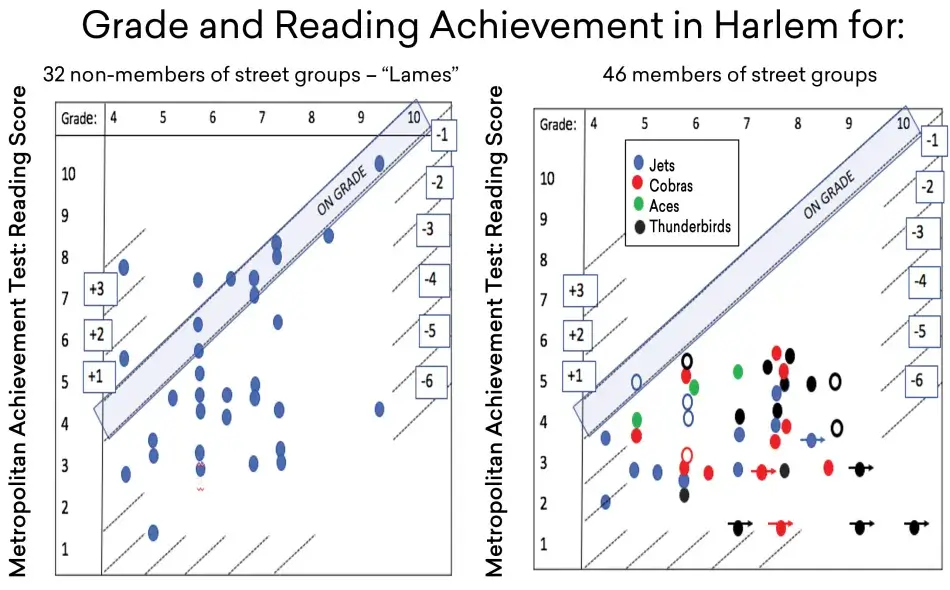
Many of the thirty-two non-members had reading problems, but there was a general upward movement: a good number read at grade level, and a few were even above it. But only one of the forty-six members of the street groups read at grade level. Many of those in the higher grades read far below grade level.
Many educational psychologists attributed this failure to “verbal deprivation,” arguing that Black children lacked any logical structure, that they come to school unable “to make statements of any kind.”11
A paper that I wrote on “The Logic of Non-Standard English” disagreed with that view.12 I gave voice to the most eloquent of the group members. The most often reprinted passage is a discussion between the interviewer (KC) and Larry Hawthorne (LH), a fifteen-year-old member of the Jets. KC asks a question: “Just say that there is a god. What color is he? White or Black?”
LH: He be White, man!
KC: Why?
LH: Why? I’ll tell you why. ‘Cause it – the average whitey out here got everything, you dig it? An’ then we ain’t got shit, you know? So, for that to happen, you know it ain’t no Black god that’s doin’ that bullshit!
This exchange was greeted with a peal of laughter from KC and others present, which registers the fact that Larry had won the logical argument using AAVE.
A special target of proponents of the “verbal deprivation” position was the absence of the copula (the verb to be). Our analysis showed that this absence is actually a form of contraction and can occur only in certain grammatical constructions. The absence of is and are in AAVE is a variable: it can be deleted only where Standard English can contract them.
In Larry’s discussion of the existence of heaven and hell, the copula has been deleted when he says: you __ good and you __ goin’. And: When they be sayin’ if you good, you goin’ to heaven.
In both of these cases, Standard English speakers could contract a copula to you’re good and you’re going. In contrast, we find Larry using the copula is later in this discussion when he says this is hell, as represented in bold type:
LH: And when they be sayin’ if you good you goin’ to heaven, that’s bullshit.
KC: Is that so?
LH: You ain’t goin’ to no heaven. ‘Cause it ain’t no heaven for you to go to.
KC: Well if there’s no heaven, how can there be a hell?
LH: I mean, yeah. . . hm. . . well let me tell you, it13 ain’t no hell, ‘cause this is hell right here, you know?
KC: So this is hell?
LH: Yeah. This is hell right here.
How do we explain Larry’s use of the full form “this is hell”? It is consistent with the fact that Standard English does not contract this structure to “this’s hell.” In other words, AAVE and Standard English are not foreign languages; they are cousins.
The quantitative analysis, published as “Contraction, Deletion, and Inherent Variability of the English Copula,”14 introduced the first linguistic use of multiple regression in the form of the Varbrul program, an ancestor of today’s mixed-level regression analysis programs.
The Ann Arbor Trial
The weight of sociolinguistic information on AAVE accumulated until it was brought to bear in a cry for social justice through legal channels. This happened when Black citizens of Ann Arbor, Michigan, sued the city for failing to teach their children to read.
Linguist Geneva Smitherman (Director of the African American Language and Literacy Program at Michigan State University) assembled the witnesses (including myself), who testified and convinced Judge Charles Joiner to find for the plaintiffs.
Judge Joiner delivered his opinion on July 12, 1979, and directed the Ann Arbor School Board to submit to him within thirty days a plan defining the exact steps that would be taken to help teachers to identify children speaking AAVE, and to use that knowledge in teaching such students how to read Standard English.
In the years that followed, very little progress was made in following Judge Joiner’s orders. Programs that build on contrastive analysis of AAVE and Standard English have been met with violent objections from parents, teachers, and the general public, who have not absorbed the linguists’ view of AAVE.
The Reading Road
In 1970, I left Columbia and came to Penn. I found that the low reading scores of Black children in Philadelphia, as in New York, had remained a barrier to their progress. Conferring with Ira Harkavy and Cory Bowman at Penn’s Netter Center for Community Partnerships, I converted my course on AAVE to an Academically Based Service-Learning course. Over twelve years, I developed The Reading Road, a tutoring program for the lower grades that used our knowledge of the alphabet and its relation to AAVE. The Reading Road is used by Penn undergraduate volunteers in the Penn Reading Initiative, tutoring second and third graders in local schools.
The stories I wrote for The Reading Road were produced as graphic novels. They give voice to young people with a long history of being blamed for things they didn’t do. Figure 3 is a crucial moment from Take Off Your Coat, a chapter that focuses on words with final consonant clusters, as in cold. The hero is sent to detention because he has refused the teacher’s command to take off his coat. The reader knows (but the teacher does not) that it is because he has ripped a hole in his pants by getting a neighbor’s cat down from a tree on the way to school.
Figure 3. The hero inexplicably refuses to take off his coat.
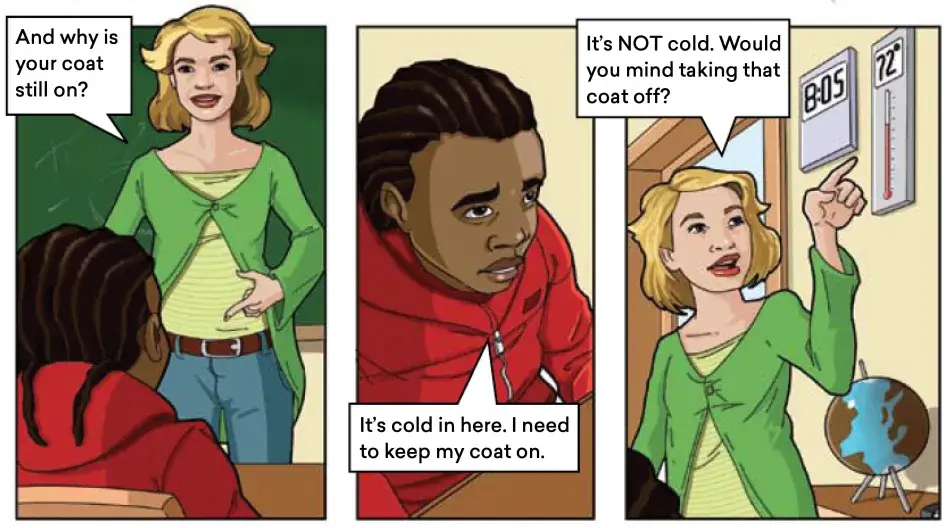
And it actually happened that way. This incident was in the school records of Larry Hawthorne, who we heard from earlier on the color of God.
Sociolinguists often take the side of the speakers they study. John Baugh, president-elect of the Linguistic Society of America (LSA), was the first to demonstrate the effect that prejudice against AAVE has on racial profiling in housing. His book, Linguistics in Pursuit of Justice, published by Cambridge University Press in 2018, had a national impact in identifying racial bias to speech. We also see this in the publications by the three linguists who nominated me for the Talcott Parsons Prize, all former presidents of the LSA. For example, in her 2019 presidential address to the Linguistic Society,15 Penelope Eckert showed that the use of double negatives was a clear symbol of resistance to school norms on the part of the young women in the high school she studied, characterizing it as “a claim to autonomy, rebelliousness, or toughness.” In a paper jointly authored with Sharese King, John Rickford called attention to the ways in which the voices of minority witnesses are obscured in the courtroom.16 And Walt Wolfram defended the use of AAVE in the Ebonics controversy.17
The Atlas of North American English and Personal Identity
One large-scale numerical project that emerged from the Penn Sociolinguistics Laboratory was The Atlas of North American English.18 The Atlas mapped the vowel systems of the United States and Canada through telephone interviews of residents in cities with a population of more than 50,000. The prevalence of active sound changes across the continent assures that native speakers of English can often be differentiated by their vowel systems in a way that persists throughout life. It also provides a dramatic example of how large-scale quantitative research can decide matters of social justice.
The Prinzivalli case
Paul Prinzivalli was a cargo handler from New York City, who was working for Pan American Airways in Los Angeles. The airline received a series of bomb threats by telephone:
“There’s gonna be a shootout tonight up there and a bomb going off.”
The executives of the airline and the police thought that the caller sounded like Prinzivalli, who was known to be a “disgruntled” employee. Prinzivalli was arrested. Prosecutors offered him a plea bargain: time served and five years’ probation for a guilty plea. Prinzivalli refused, although he knew he faced possibly six to eight years in prison if found guilty.
Since the case involved voice identification, and because Prinzivalli was from New York City, Sandra Disner of the Phonetics Laboratory at UCLA sent me a copy of the tapes. As soon as I heard the recordings, I knew that Prinzivalli was innocent. The bomb threats were made by someone with an Eastern New England phonology, in which bomb has the same vowel sound as off. For Prinzivalli, a New Yorker, these vowel sounds are very different. The question then was how to convey this to Californians, for whom New Yorkers and New Englanders sound the same?
I was told that expert witnesses had to limit their testimony to giving opinions of the evidence. But I looked for a way to establish that Prinzivalli’s innocence was a fact. I showed Judge Gordon Ringer the acoustic measurements of vowels in the bomb threat caller’s statement and of Prinzivalli’s repetitions of bomb and off. The analyses demonstrated that the bomb threat caller had the same vowel in bomb and off, and Prinzivalli had different vowels, as shown in Figure 4.
Figure 4. Acoustic Measurements for bomb and off for the Bomb Threat Caller and Prinzivalli

The evidence of The Atlas in Figure 5 shows that geographic distributions of these two systems do not overlap.
Figure 5. Pronunciations of bomb and off in New York and Eastern New England
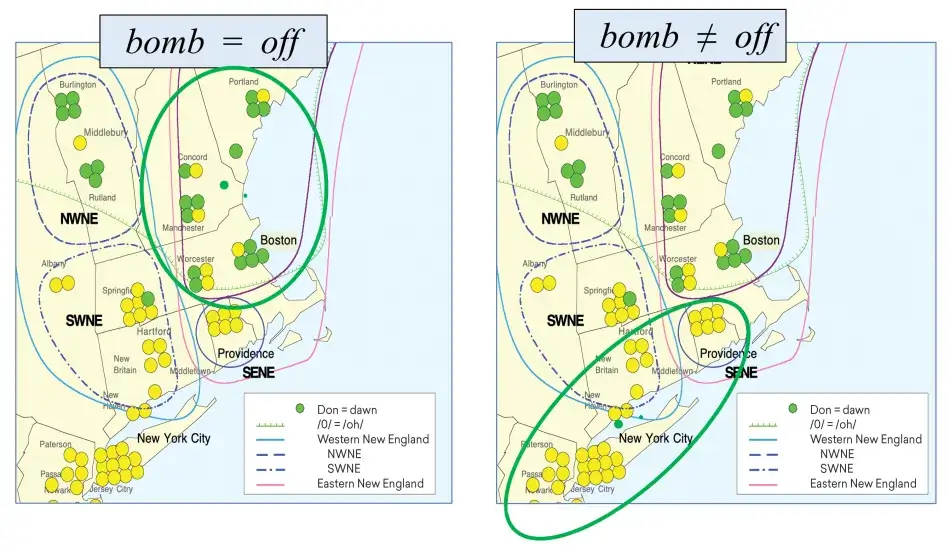
The trial adjourned on Friday afternoon. On Monday morning, Judge Ringer asked the attorneys if they had any further evidence to present. They did not. The judge then asked Prinzivalli to stand and to recite the Pledge of Allegiance. Prinzivalli said: “I pledge allegiance to the flag of the United States of America.” The judge then said to me, “What can you tell me about that?” I said, “It shows he’s a New Yorker, because it’s the only dialect in the Eastern United States where flag has the same vowel as the word yeah.”
The judge found the defendant not guilty on the basis of the linguistic evidence, which he described as “objective” and “powerful.” He later told The Los Angeles Times that “it was the ‘ah’s’ and the ‘oh’s’ that did it.” The prosecutor had to agree with this assessment.
Prinzivalli later sent me a thank you card that said that he had spent fifteen months in jail waiting for someone to demonstrate the truth of the matter as I had done. I have had many scientific results in which the convergence of evidence was so strong that I felt that I had laid my hands on the reality behind the surface, but nothing could be more satisfactory for any scientific career than to separate fact from fiction, as in this case. By means of linguistic evidence, one man could be freed from the corporate enemies who had assailed him, and another could sleep soundly on the conviction that he had made a just decision.
© 2021 by William Labov
To view or listen to the presentation, visit www.amacad.org/events/honoring-labov.